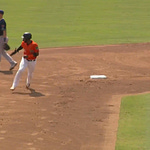Baseball is often decided not by the big swings or highlight-reel plays but by the subtle, situational decisions that happen between the lines. One of the most misunderstood? Tagging up from second base. Especially in extra innings, when every 90 feet is scrutinized and magnified, understanding the real cost-benefit of advancement is what separates sharp teams from ones just going through the motions.
Let’s break down a moment from the Giants-Dodgers game just before the All-Star break bottom of the 10th, tie game, runners on first and second, one out. A line drive to center field is caught. No one tags up. At first glance, it looks like a non-event. But it’s not. It’s a teaching moment.
The Play:
Bottom 10, tie game.
Runners on 1st and 2nd, 1 out.
Devers lines one to center.
Caught cleanly—neither runner tags.
No one moves. And a lot of people get angry about the non-tag. But here’s why this moment matters—and why teaching it properly can win you a game down the road.
Tagging from Second with One Out: A Bad Bet
It feels like advancement. It looks like progress. But it’s not. If you're on second base with one out and tag up to get to third? You're in the same spot from a run-scoring perspective. With two outs, you still need a base hit to score. The number of additional avenues to bring a runner in from third with two outs—wild pitch, passed ball, error—is low. Trying to squeeze out that 90 feet is usually all risk, very little reward.
If you get thrown out at third? Inning over. That’s not a small mistake—it’s a game-changing decision.
The lesson: Advancing from second to third with one out on a fly ball is rarely worth it.
Same Play, No Outs? Whole Different Conversation
Let’s rewind and imagine that same scenario with no outs.
Now, tagging to third changes the equation. One out and a runner on third base in extras unlocks multiple options:
Sac fly
Grounder to the right side (Maybe not in extras but in some situations)
Wild pitch or passed ball
Error under pressure
That 90 feet becomes valuable. With no outs, you want to press the issue apply pressure. But even then, it’s not reckless. The key is positioning: get off the bag far enough to score if it drops, but close enough to tag and go if it’s caught. That’s real situational awareness.
The lesson: With no outs, get to third. It opens the door to manufacturing a run.
What to Focus On:
Count Outs First
Every decision flows from the number of outs. Drill this into them.Know What That 90 Feet Gets You
It's not always worth it. If you're not gaining run scoring probability, don’t take the risk.Practice Decision Zones
Situational tags aren’t reaction plays—they’re prepared plays. Use cone drills, game scenarios, even film sessions to define where runners should be and why.Talk About the Cost of the Final Out
Remind players: The last out of an inning—or game—is not the same as the first. Reckless aggression looks gritty, but it can lose you ballgames.
Teaching baseball isn’t just about getting reps in—it’s about getting reps that matter. Plays like these quiet, forgettable on the surface—are the 5% decisions that decide postseason outcomes. And the good teams? They don’t wing it. They prepare for this exact moment.
So ask your players next time they’re on second base with one out what’s the plan if the ball’s hit to the outfield? If they don’t have an answer, then you’ve got something to work on.












Share this post